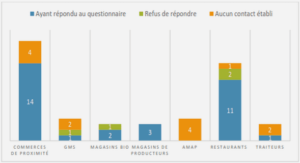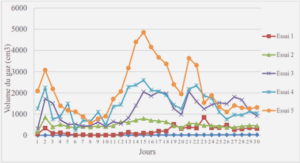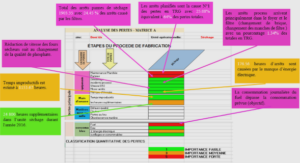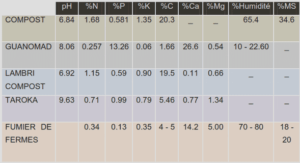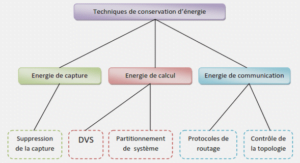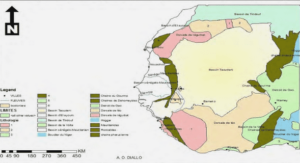COUCHE D’OZONE ET RAYONNEMENT ULTRAVIOLET -B.
NON-SYNERGISTIC EFFECTS OF W AT ER SOLUBLE CRUDE OIL AND ENHANCED ULTRAVIOLET-B RADIATION ON A NATURAL PLANKTONIC
ASSEMBLAGE
RÉsUMÉ
La présente étude démontre les effets de la fraction soluble (WSF) d’un pétrole brut d’une part, du rayonnement ultraviolet-B accru (RUVB : 280-320 nm) d’autre part, et de la combinaison WSF+RUVB sur un assemblage planctonique naturel « 150 J-lm) de l’Estuaire du Saint-Laurent. Afin d’étudier aussi bien les effets individuels de chacun de ces stress que leurs effets combinés, 12 microcosmes (91) ont été immergés dans la colonne d’eau de mésocosmes plus grands (sacs en polyéthylène: 1800 1), donnant lieu aux 4 traitements expérimentaux suivants, chacun en triplicata : (1) NUVBR+WSF (RUVB naturel avec addition de la WSF), (2) HUVBR+WSF (RUVB accru avec addition de la WSF), (3) NUVBR (RUVB naturel sans WSF), et (4) HUVBR (RUVB accru sans WSF). Pendant 5 jours consécutifs, nous avons mesuré le rayonnement incident, les concentrations en éléments nutritifs et en hydrocarbures dissous, ainsi que les changements temporels de la production et de l’abondance du phyto- et bactérioplancton. Nous avons ainsi pu observer un fort impact de la WSF et un impact moindre du RUVB sur l’assemblage phytoplanctonique avec une diminution des taux de croissance, accompagnée par une augmentation de la taille cellulaire moyenne, reflétant une perturbation du cycle de division cellulaire. En se référant au traitement NUVBR, ces résultats ont conduit à une réduction de 84, 79 et 60% dans l’abondance totale des cellules < 20J-lm, et cela dans les traitements HUVBR+WSF, NUVBR+WSF et HUVBR respectivement. Les abondances bactériennes ont montré des valeurs significativement plus importantes dans les deux traitements contaminés avec l’addition de la WFS, et cela comparativement au traitement NUVBR.
Cependant, l’incorporation bactérienne de thymidine a montré des variations nycthémérales, suggérant des dommages cumulatifs à l’ADN induits par le RUVB et/ou la WSF, ainsi que l’existence potentielle de mécanismes de réparation avec la co-occurrence d’une plus grande disponibilité en substrats de croissance. L’absence de différences significatives entre les deux traitements contaminés par la WSF suggèrent qu’il n’y a pas eu d’interaction d’addition entre le RUVB et la WSF. Cette étude apporte la première évidence de l’interaction non-synergique entre les deux stress et suggère que sous l’importance des effets délétères de la WSF, les effets induits par le RUVB sur les microorganismes marins peuvent être complètement masqués. Mots-clés : rayonnement ultraviolet-hydrocarbures dissous-effet nonsynergique-phytoplancton-bactéries.
INTRODUCTION
Solar UV-B radiation (UVBR: 280-320 nm) reaching the Earth’s surface has increased during recent years due to ozone depletion and tbis has prompted research on their effects on phyto- and bacterioplankton assemblages due to their importance in the global carbon cycle. Several investigations have shown that UVBR inhibits phytoplankton photosynthesis (Vincent & Roy 1993, Bergmann et al. 2002), growth and cell division (Karentz et al. 1991, Buma et al. 1997, Mostajir et al. 1999a), nutrient uptake (Fauchot et al. 2000, Mousseau et al. 2000), and induces changes in aIgai specific composition (Neaie et al. 1994, Mostajir et al. 1999a,b, Wangberg et al. 2001). Bacterioplankton is also affected by UVBR in several ways, including a reduction in bacteriai production (Aas et al. 1996, Chatila et al. 2001), as weil as in their abundance (Müller-Niklas et al. 1995) and viability (Vincent & Roy 1993). Such planktonic responses to enhanced UVBR are species-specific due to difference in UVBR sensitivity (Neale et al. 1998). Moreover, planktonic response may differ according to the latitude (Longhi 2003). Indeed, UVBR shows a bigh variability,
and particularly due to changes in solar elevation with latitude. It is therefore expected that ceUs are more or less UVBR-sensitive, depending on their light environment (Helbling et al. 1992). On the other hand, recent environmental work has focused on the toxicity induced by simultaneous exposure to naturai solar radiation and environmentai contaminants (Liess et al. 2001). For example, it has been demonstrated that aquatic ecosystems may be impaired through the light-mediated phototoxicity of light polycyclic aromatic hydrocarbons (P AHs) present in the water soluble fraction (WSF) of crude oil (Marwood et al. 1999). Photoactivation of P AHs by natural irradiance, especially UVBR, is one of the most important routes of their enhanced toxicity in marine environment (Huang et al. 1993, McConkey et al. 1997). Such photoinduced toxicity results from photosensitization (with reactive oxygen species formation) and photomodification (defined here as photooxidation and/or photolysis) processes. In the latter, photoproducts formation occurs, and these new compounds are considered to be more toxic than initial compounds (McConkey et al. 1997, Mallakin et al. 1998). Combined and/or synergistic effects of PAHs and UVBR exposure are therefore highly relevant in ecotoxicology, because P AHs are a prevalent group of organic contamÏnants in surface waters (OSB 2003). Moreover, according to current predictive models, ozone depletion will continue to occur in 2010-2019, with a likely ozone hole perhaps as big as the present one over Antarctica but over the North Pole (Schindell et al. 1998). It was therefore interesting to assess the planktonic assemblage responses to dual stresses and to determine whether these responses differ according to the latitude. In tbis context, a series of mesocosms experiments were conducted at two latitudes: northem temperate (Rimouski; Canada), and southem temperate (Ushuaia; Argentina), periodically exposed to ozone hole conditions. We present here the first part of these results, which corresponds to the study of the effects of UVBR and WSF ( dissolved PARs) on a natural planktonic assemblage from the St. Lawrence Estuary (Rimouski, Canada).
|
Table des matières
LISTE DES FIGURES
LISTE DES TABLEAUX
LISTE DES ABBRÉVIA TIONS
INTRODUCTION GÉNÉRALE
C ONCEPT D’INTERACTIONS ET DE STRESS MULTIPLES
C OUCHE D’ OZONE ET RA YONNEMENT ULTRAVIOLET -B
RÉACTIONS PHOTOCHlMIQUES ET RAYONNEMENT ULTRAVIOLET -B
C OMMUNAUfÉS PLANCTONIQUES ET RAYONNEMENT ULTRAVIOLET -B
Phytoplancton et rayonnement ultraviolet-B
Bactérioplancton, réseaux trophiques et rayonnement ultraviolet-B
CONTAMINANTS, COMMUNAUfÉS PLANCTONIQUES ET RAYONNEMENT ULTRAVIOLET -B
Hydrocarbures aromatiques polycycliques
Biodégradation et toxicité
Tributylétain
Biodégradation et toxicité
Photodégradation
APPROCHE EN MÉSOCOSMES
OBJECTIFS ET HYPOTIIÈSES DE TRA V AIL
CHAPITRE 1: NON-SYNERGISTIC EFFECTS OF WA TER SOLUBLE CRUDE OIL AND ENHANCED ULTRAVIOLET-B RADIATION ON A NATURAL
PLA.NKTONIC ASSEMBLAGE
RÉsUMÉ
ABSTRACt
INTRODUCTION
MATERIALS AND METHODS
Experimental set-up
Physical measurements in the mesocosms
Chemical measurements in the microcosms
Biological measurements in the microcosms and calculations
Statistical analyses
RESULTS
Light and UVBR irradiances
Chemical parameters
Biological parameters
DISCUSSION
Relevance ofUVBR exposure levels
Relevance ofWSF toxicity
Mechanisms and relevance ofWSF addition upon the planktonic assemblage
Mechanisms and relevance ofenhanced UVBR upon the planktonic assemblage
Relevance of combined effects ofWSF and enhanced UVBR
REFERENCES
CHAPITRE 2: CASE STUDY OF MULTIPLES STRESSORS ON A NATURAL PLANKTONIC ASSEMBLAGE: WATER SOLUBLE CRUDE OIL AND
ENHANCED UVBR LEVEL AT USHUAIA
RÉsUMÉ
ABSTRACT
INTRODUCTION
MATERIALS AND METHODS
Experimental set-up
Incident solar radiation & UV profiles
WSF preparation, addition and chemical analysis
Fluorescence induction analysis
Pigment analysis
Flow cytometry analysis
Heterotrophic bacterial counts
Statistical analysis
RESULTS
Chemical analysis
DISCUSSION
UVBR effects on the natural planktonic assemblage
WSF effects on the natural planktonic assemblage
Relevance of the UVBR and WSF co-exposure
CONCLUSIONS
REFERENCES
CHAPITRE 3: TBT TOXICITY ON A NA TURAL PLANKTONIC ASSEMBLAGE EXPOSED TO ENHANCED ULTRA VIOLET-B RADIATION
RÉsUMÉ
ABSTRACT
INTRODUCTION
MATERIALS AND METHODS
Experimental set-up
Tributyltin addition and chemical analyses
Biological analyses
Statistical analyses
RESULTS
Biochemical parameters
ChI a concentrations and in vivo fluorescence
Phytoplankton abundances, cellular characteristics and growth rates
Bacterial abundance and productivity
DISCUSSION
Magnification of TBT phytotoxicity under UVBR exposure
Direct and indirect feedbacks on bacterioplankton
CONCLUSIONS
REFERENCES
DISCUSSION GÉNÉRALE ET CONCLUSIONS
ANNEXE
BffiLIOGRAPHIE
![]() Télécharger le rapport complet
Télécharger le rapport complet

